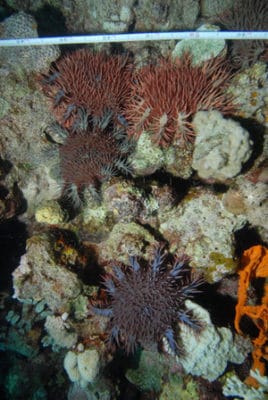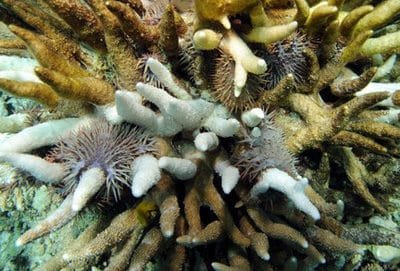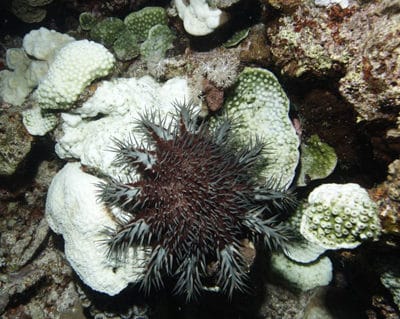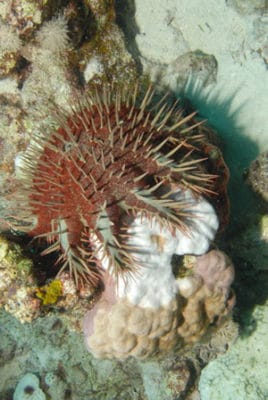The Farasan Banks is a very unique and diverse marine ecosystem with more reef habitat per unit area than anywhere else we’ve surveyed along the Saudi Arabian Red Sea coast. Like other areas, the major framework builders of these structures are slow-growing massive colonies of Porites. Unlike many Indo-Pacific reefs, where branching acroporids are the most common and abundant corals, colonies of Porites are by far the most numerous, and largest corals, also making up most of the cover. There are many branching corals – especially Acropora, and an unusually high diversity of other corals. While we are still compiling a species list, I’m guessing we will have seen about 165 different stony corals – or more than 80% of the coral taxa reported for the Red Sea. These all live in, among and on Porites colonies, often settling on the dead framework.
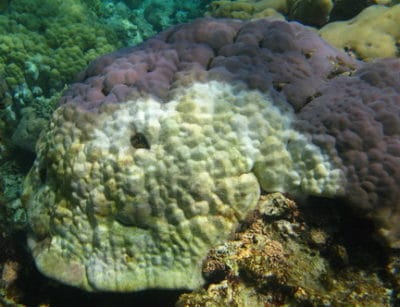
2m Porites with large COTS lesions.
Like other corals, Porites colonies are often missing parts of their tissue. In some areas most of these corals had died, but hundreds of other corals had colonized their hard skeletons. One of the advantages of being a coral, such as Porites, is that these are colonial animals. In difficult times, they may regress, surviving as tiny remnants on a former skeleton of much larger size. But through resheeting, they can recover, growing over their former skeleton once again, continue expanding in size, and accrete new tissue and skeleton. These corals provide critical habitat for lots of other animals and plants. Holes and fissures between the corals provide refuge for fishes and invertebrates, places for them to feed, and places to reproduce. Often, there were several meters of relief from the top of one colony to the underlying reef platform. Corals may be separated by deep sand channels. The reef may also slope gradually to deeper water, or drop abruptly into the depths; a maze of channels, undercut ledges, caves, nooks and crannies.
Some of the animals that hide in these spaces also may eat the coral. As you swim over the reef, you may not even know they are there. One of these, the crown of thorns seastar (COTS) is a very important force structuring Red Sea coral reefs. They’ve been known to occur in this region since at least the 1940s or 1950s, and some very elegant studies were done to better understand their role in reef ecology during the 1970s.
What’s intriguing about these animals is they appear to be on every reef we looked at. In many locations we never saw them, but signs of their presence were identified. These signs could easily be misinterpreted, and it is likely that they are often misinterpreted as disease or some other stressor.
One of our goals of this Expedition, as I have mentioned before, is to determine how resilient these reefs are and identify factors that could be responsible for large scale disturbances we have witnessed in several locations. Why do some reefs have few or no remaining large corals while others are packed full of large corals? Based on the unprecedented levels of recruitment and abundance of very small, multi-species, juvenile corals, we are confident that disturbed areas are on the road to rapid recovery. I look forward to coming back to some of these same sites over the next several years to witness this rebirth.
It is, however, more difficult to find the smoking gun that caused the loss of coral. Too often, we try to attribute this to a single factor, while there are likely to be a multitude of interrelated causes. With a bit of luck, some baseline (pre-disturbance) data and knowledge of some unusual event (such as abnormally high sea water temperatures) combined with the opportunity to survey the reefs during the peak of this unusual event, you can assess the impacts and pinpoint the cause. That doesn’t usually happen.
Identifying what caused change, such as the reason why a reef died, months to years after it died is not easy. Without observing many sick corals, watching them continue to lose tissue, or seeing a reef that has bleached and then never regain their symbiotic algae, you cannot point a finger at disease or bleaching. If you can get high-quality remotely sensed data on sea surface temperatures, however, you can start to build a case.
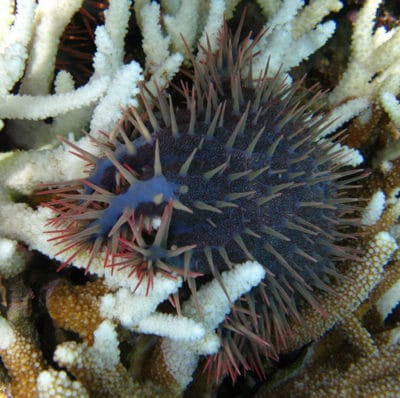
A close-up view of a crown of thorns seastar.
However, you will still never know if this was the only factor or what else could have happened. For instance, we know that coral diseases are more common, many are more virulent, and coral hosts have lowered resistance during warmer parts of the year. Some corals are also adapted to higher temperatures, such as those that occur in shallow water may be particularly well adapted because they are routinely exposed to hot water and other environmental perturbations.
Fortunately, during this Expedition, we learned of one very important structuring agent: the crown of thorns sea stars (COTS). Just by chance, we happened to visit two locations with unusually high numbers of these COTS. On every dive I have seen colonies that experienced partial or complete mortality, still stark white, indicating they died in the last day or two. Sometimes there was a bit more recent mortality in certain sites and sometimes it was only one or two corals. Those that completely died were usually very small (less than 10-15 cm), but many were massive corals which are notoriously slower growing. Larger colonies, such as several meter wide Porites, were also affected and typically these were missing a baseball- or basketball-sized patch of tissue.
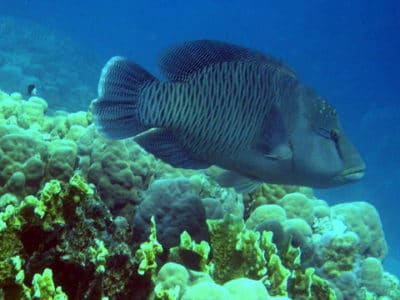
A COTS consumer: the humphead wrasse.
Looking at this pattern of mortality, I could exclude disease since most of the diseases we see move across the coral in a band-like manner or form small lesions within the colony that slowly radiate out. You don’t usually see a large patch of tissue that died all at once. I could also exclude predation by other animals, such as snails. While I did see a lot of snail damage, I could also find the snails if they were the culprit. Additionally, there was a lot of tissue loss from fish, but these were also associated with erosion of the underlying skeleton.
We found one reef with probably the largest stand of branching corals we’ve seen in the region. It was a colorful, vibrant reef that was supporting more fish than many other locations. Yet, there were also a lot of white patches on corals and many corals that had been killed within the last week.
A quick survey did not provide any evidence of COTS. We had to really search hard and occasionally we could find one of these voracious predators tucked beneath the coral. Often, though, there were white patches on coral and what seemed to be an absence of COTS. It took a night dive to definitively diagnose the source of mortality. A few hours after dark, these animals emerge from their refuge to continue eating where they had left off. A lot of COTS were out feeding, but there were probably less than 100 or so on the entire reef. Some were on month-old dead corals, which suggested that they had been slowly eating the corals on this reef, possibly for many months.
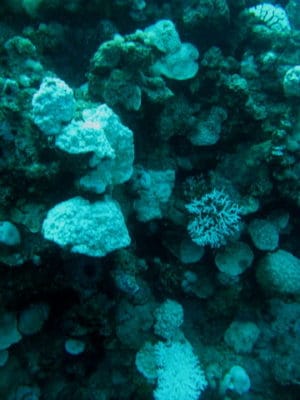
A reef with recently eaten corals.
We found another beautiful reef with a shallow central lagoon filled with Porites bommies and a mix of colorful branching corals. The reef sloped vertically on all sides, with ledges, terraces, and undercut ridges, similar to what we had experienced in other locations. On the exposed side, there was unusually high coral cover with areas from 10-15m depth and 60-70% living coral. There were huge foliose plates, large massive colonies and delicate branching species. On a separate dive, we entered the water on the leeward side. Swimming over the crest, I knew right away something was amiss.
Everywhere I looked there were dead corals, some of which still had small patches of living tissue and others were little more than a perfectly intact skeleton. These had died within the last week or so – fine sediments had accumulated on their surfaces, and in some cases they were already colonized by green fuzz.
I swam on another hundred meters or so, and came upon an area that looked like it had just snowed. As far as I could see, stark white corals stood out in harsh contrast to the brownish reef substrate. Swimming a bit closer, I immediately identified the cause: crown of thorns seastars! This reef had a population explosion of these critters. Hundreds of animals were out in the open, feeding on coral. I measured the affected area with the highest numbers of COTS, a few hundred square meters overall, and began counting animals. I stopped counting at 467. There were probably many I missed.
I ran a series of transects to get a better handle on what they were eating and how dense they were. Within 10 square meters I had densities of 40-60 animals. There appeared to be very few species they were not eating as they consumed everything from branching acroporids, massive Porites, Echinopora, Stylophora, Montipora, Lobophyllia, Favia… and the list goes on.
What was interesting though, some corals were unaffected, while neighbors often of the same species, had been entirely consumed. They also appeared to aggregate on individual corals, like 5-6 COTS all feeding on a single colony. This has been reported before. There is one thought that the seastars release some type of pheromone to attract other COTS when they discover a reef with an abundant food source.
While we don’t know what caused this outbreak, we do know this type of behavior has occurred for decades. In the past, reefs have been able to recover from this disturbance, only to become victim to these voracious animals years later. I also am convinced now of the importance of these keystone predators as they are a major force structuring the reefs in the Kingdom of Saudi Arabia.
